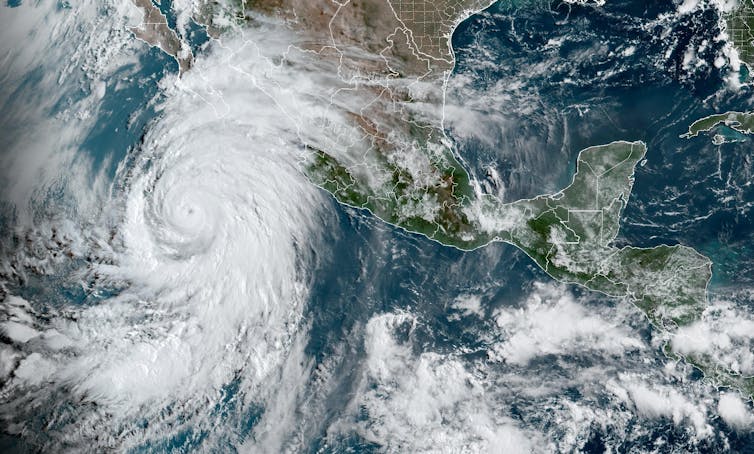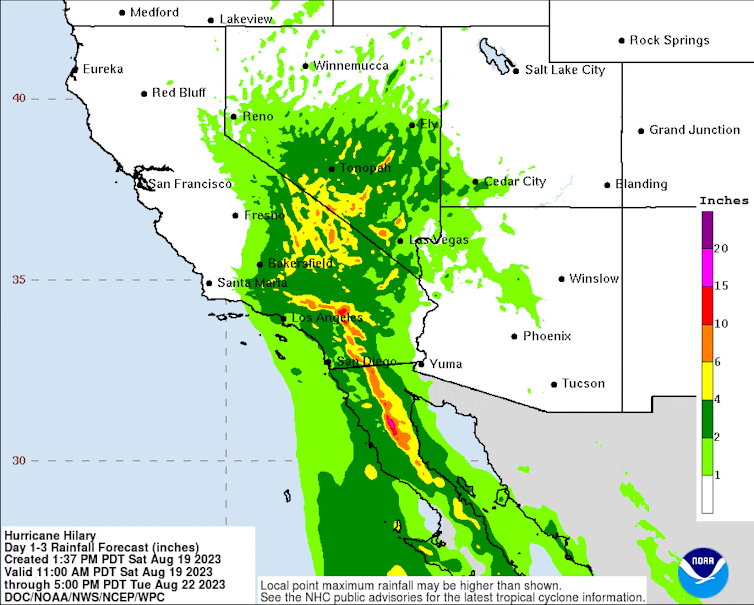
Experts in autocracies have pointed out that it is, unfortunately, easy to slip into normalizing the tyrant, hence it is important to hang on to outrage. These incidents which seem to call for the efforts of the Greek Furies (Erinyes) to come and deal with them will, I hope, help with that. As a reminder, though no one really knows how many there were supposed to be, the three names we have are Alecto, Megaera, and Tisiphone. These roughly translate as “unceasing,” “grudging,” and “vengeful destruction.”
So today is – or was – depending on when you get here – the first hurricane to land on California in living memory – and when I say living memory, I mean the people who were alive in California at the time of the Spanish conquest. And probably much longer – but we don’t have records on that. As a native of California myself, I didn’t feel that I could ignore this. But it’s an issue much bigger than California – after all, New York didn’t get hurricanes either – until it did. Climate change is bringing tropical storms out of tropical areas nd into the temperate zone. I don’t think it’s wise to wait until the first hurricane hits Alaska to read up on, and discuss, the subject.
==============================================================
Hurricane Hilary triggers Southern California’s first tropical storm warning ever, with heavy rain and flash flooding forecast

NOAA NESDIS
Nicholas Grondin, University of Tampa
Hurricane Hilary headed for Mexico’s Baja peninsula on Saturday, Aug. 19, 2023, and was forecast to speed into Southern California at or near tropical storm strength on Sunday. For the first time ever, the National Hurricane Center issued a tropical storm warning for large parts of Southern California and warned of a “potentially historic amount of rainfall” and “dangerous to locally catastrophic flooding.”
Hurricane scientist Nick Grondin explains how the storm, with help from El Niño and a heat dome over much of the country, could bring flash flooding, wind damage and mudslides to the U.S. Southwest.
How rare are tropical storms in the Southwest?
California has only had one confirmed tropical storm landfall in the past. It was in September 1939 and called the Long Beach Tropical Storm. It caused about US$2 million dollars in damage in the Los Angeles area – that would be about $44 million today. A hurricane in 1858 came close but didn’t make landfall, though its winds did significant damage to San Diego.
What the Southwest does see fairly regularly are the remnants of tropical cyclones, storms that continue on after a tropical cyclone loses its surface circulation. These remnant storms are more common in the region than people might think.
Just last year, Hurricane Kay took a similar track to the one Hurricane Hilary is on and brought significant rainfall to Southern California and Arizona. Famously, Hurricane Nora in 1997 made landfall in Mexico’s Baja California and kept moving north, bringing tropical storm-force winds to California and widespread flooding that caused hundreds of millions of dollars in damage, particularly to fruit trees and agriculture.

National Hurricane Center
A study led by atmospheric scientist Elizabeth Ritchie in 2011 found that, on average, about 3.1 remnant systems from tropical cyclones affected the U.S. Southwest each year from 1992 to 2005. That’s a short record, but it gives you an idea of the frequency.
Typically, the remnants of tropical cyclones don’t go beyond California, Nevada and Arizona, though it wouldn’t be unprecedented. In this case, forecasters expect the effects to extend far north. The National Hurricane Center on Aug. 18 projected at least a moderate risk of flooding across large parts of Southern California, southern Nevada and far-western Arizona, and a high risk of flooding for regions east of San Diego.
What’s making this storm so unusual?
One influence is the El Niño climate pattern this year, which is showing signs of strengthening in the Pacific. Another, which might be less intuitive, is the heat dome over much of the U.S.
During El Niño, the tropical Pacific is warmer than normal, and both the eastern and central Pacific tend to be more active with storms, as we saw in 2015 and 1997. Generally, hurricanes need at least 80 degrees Fahrenheit (27 degrees Celsius) to maintain their intensity. Normally, the waters off Southern California are much cooler. But with the high initial intensity of Hurricane Hilary over warm water to the south, and the fact that the storm is moving fast, forecasters think it might be able to survive the cooler water.
The influence of the heat dome is interesting. Meteorology researcher Kimberly Wood published a fantastic thread on X, formerly known as Twitter, describing the large-scale pattern around similar storms that have affected the southwestern United States. A common thread with these storms is the presence of a ridge, or high-pressure system, in the central U.S. When you have a high-pressure system like the heat dome covering much of the country, air is pushed down and warms significantly. Air around this ridge is moving clockwise. Meanwhile, a low-pressure system is over the Pacific Ocean with winds rotating counterclockwise. The result is that these winds are likely to accelerate Hilary northward into California.
Despite the rarity of tropical cyclones reaching California, numerical weather prediction models since the storm’s formation have generally shown Hilary likely to accelerate along the west coast of Baja California and push into Southern California.
What are the risks?
The threat of tropical storm-force winds led the National Hurricane Center to its first-ever tropical storm watch for Southern California on Aug. 18. However, water is almost always the primary concern with tropical storms. In California, that can mean flash flooding from extreme rainfall enhanced by mountains.
When a tropical storm plows up on a mountain, that can lead to more lifting, more condensation aloft and more rainfall than might otherwise be expected. It happened with Hurricane Lane in Hawaii in 2018 and can also happen in other tropical cyclone-prone locations with significant orographic, or mountain, effects, such as the west coast of Mexico.
That can mean dangerous flash flooding from the runoff. It can also have a secondary hazard – mudslides, including in areas recovering from wildfires.
In dry areas, heavy downpours can also trigger flash flooding. Forecasts on Aug. 18 showed Death Valley likely to get about 4 inches of rain over a three-day period from the storm – that’s about twice its average for an entire year. Death Valley National Park warned of flash flooding Aug. 19-22 and closed its visitor centers and campgrounds.
As Hurricane Hilary heads toward landfall in Baja California, forecasters are expecting dangerous flooding, storm surge and wind damage in Mexico before the storm reaches Southern California.
Keep in mind this is still an evolving situation. Forecasts can change, and all it takes is one band of rain setting up in the right spot to cause significant flooding. Those in the path of Hilary should refer to their local weather offices for additional information. This would include local National Weather Service offices in the United States and Servicio Meteorológico Nacional in Mexico.
This article was updated Aug. 19, 2023, with the National Hurricane Center upgrading the tropical storm watch to a tropical storm warning.![]()
Nicholas Grondin, Assistant Professor of Environmental Studies, University of Tampa
This article is republished from The Conversation under a Creative Commons license. Read the original article.
==============================================================
Alecto, Megaera, and Tisiphone, no matter how far one lives from a coast, it’s time to start thinking about what to do in the event of a hurricane. If you’re separated from the coast by a tall mountain range, you may have a little extra time – but I doubt whether California’s coastal range (which we always belittlingly referred to as “the foothills”) are going to stop a storm. And the Mississippi River would appear to give any hurricane a straight route northwards. Anyone outside the US, I’m not knowledgeable enough to address.
Beau of the Fifth Column, who lives in Florida, has made many a video advising people there, and through the south and even the northeast, how to prepare. They include about everything you would think of and some things that you wouldn’t. He just made his first one for California. It includes tips on how to read the weather maps – excellent advice for a newbie – but I didn’t hear him mention having a plan for your pets in case evacuation becomes necessary. Well, maybe from fires, Californians will be aware of that.
The Furies and I will be back.

Sorry, the comment form is closed at this time.